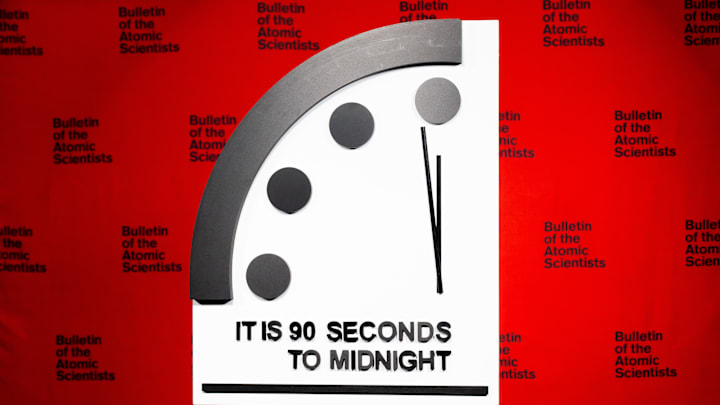On January 24, 2023, the Bulletin of the Atomic Scientists announced that its Doomsday Clock was being shifted to 90 seconds to midnight—30 seconds closer to theoretical nuclear annihilation than the last time it was reset in 2020.
If you haven’t heard of the Doomsday Clock, here’s a brief and terrifying synopsis for you: It was created in 1947 at the University of Chicago as an easy analogy to show people how close we are to Armageddon at any given moment. “Midnight” on the clock represents doomsday, and, obviously, the closer the hands are to midnight, the closer we are to nuclear oblivion.
In a statement, the organization said the reset is due largely to Russia’s invasion of Ukraine and the continuing climate crisis. “We are living in a time of unprecedented danger, and the Doomsday Clock time reflects that reality. [Ninety] seconds to midnight is the closest the clock has ever been set to midnight, and it’s a decision our experts do not take lightly,” said Dr. Rachel Bronson, the group’s president and CEO.
When the Doomsday Clock was first “set” in 1947, during the Cold War, we were at 11:53 p.m. Since then, it’s been readjusted 25 times. Here are 11 of those adjustments and why they happened.
1. 1953 // Two Minutes to Midnight
By 1953, the clock had lost five minutes, putting the time at 11:58. But there was good reason: It was the time period during which the U.S. and the Soviet Union were testing nuclear weapons.
2. 1963 // 12 Minutes to Midnight
A decade later, the clock had not only gained back those five minutes—it had doubled them. The clock was at 11:48 thanks to increased studies and scientific understanding of the dangers of nuclear weapons. This was the same year the U.S. and the Soviet Union signed the Partial Test Ban Treaty, which limited nuclear testing.
3. 1968 // Seven Minutes to Midnight
Although things were looking up regarding the Soviet Union, by 1968, France and China had developed nuclear arsenals and the U.S. was embroiled in the Vietnam War. Due to those events, the clock lost five minutes, putting us at 11:53.
4. 1972 // Twelve Minutes to Midnight
Between 1968 and 1972, the U.S. Senate passed the Nuclear Non-Proliferation Treaty and the Soviet Union signed the Strategic Arms Limitation Treaty and the Anti-Ballistic Missile Treaty. The three treaties equaled five minutes gained on the clock, putting us back at 11:48.
5. 1974 // Nine Minutes to Midnight
The successes of the U.S. and Soviet treaties were offset by India, which tested its own nuclear device in 1974. The clock lost another three minutes and was reset to 11:51.
6. 1984 // Three Minutes to Midnight
By the early 1980s, the U.S. and the USSR weren’t as agreeable as they had been during nuclear negotiations, and discussions had kind of stalled. The arms race was spiraling out of control, terrorists were becoming more active, and the Soviet invasion of Afghanistan had sharpened the division between the United States and the USSR. These factors resulted in a loss of six minutes, putting us closer to midnight than we had been since 1953.
7. 1991 // 17 Minutes to Midnight
But then things started to look up. By 1991, more treaties had been signed, the Berlin Wall had been torn down, the Soviet Union had dissolved, and the Iron Curtain had fallen. The clock gained a whopping 14 minutes, putting us at 11:43, the furthest we have ever been from midnight.
8. 1998 // Nine Minutes to Midnight
Unfortunately, the good times didn’t last long. In 1998, India and Pakistan both tested nuclear weapons and countries around the world increased military spending. The clock lost eight minutes, putting us back in the 10-minute window at 11:51.
9. 2002 // Seven Minutes to Midnight
We hadn’t gained any ground by 2002—in fact, we lost some. The U.S. rejected arms control treaties, probably as a reaction to 9/11, and announced it was withdrawing from the previously signed Anti-Ballistic Missile Treaty. These actions resulted in a loss of two minutes; the clock read 11:53.
10. 2015 // Three Minutes to Midnight
The clock lost another two minutes in 2007 thanks to North Korea’s nuclear tests and the uncertainty of Iran’s nuclear actions. Two more were lost in 2015 because the United States and Russia began modernizing their nuclear weapons programs—and the threat of climate change was added to the previous worries of nuclear destruction.
11. 2017 // Two Minutes and 30 Seconds to Midnight
The 30-second decrease in 2017 marked the first time the group had set the clock ahead less than a full minute. They were deeply troubled by then-President Donald Trump’s “statements and actions” but acknowledged that it was still early in his administration. “He has made ill-considered comments about expanding the U.S. nuclear arsenal,” they wrote in a statement. “He has shown a troubling propensity to discount or outright reject expert advice related to international security, including the conclusions of intelligence.”
A version of this story ran in 2017; it has been updated for 2023.
